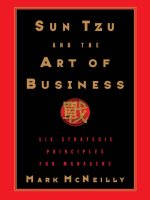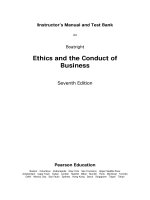Ethics and the conduct of business 8th by john boatright and smith 2017 chapter 9
Bạn đang xem bản rút gọn của tài liệu. Xem và tải ngay bản đầy đủ của tài liệu tại đây (126.11 KB, 19 trang )
Ethics and the Conduct of Business
Eighth edition
Chapter 9
Health and Safety
Copyright © 2017, 2012, 2009 Pearson Education, Inc. All Rights Reserved
Modules
•
Introduction: Health and Safety
•
9.1: Rights in the Workplace
•
9.2: Hazardous Work
•
9.3: Reproductive Hazards
•
9.4: Product Safety
•
Conclusion: Health and Safety
Copyright © 2017, 2012, 2009 Pearson Education, Inc. All Rights Reserved
Learning Objectives (1 of 2)
•
9.1: Explain the nature of ethical issues regarding occupational health and safety, employers’
obligations to protect their employees, and the arguments over the extent of employers’ responsibilities
for injury or harm
•
9.2: Analyze the rights of employees to be informed about potential health and safety hazards and to
refuse hazardous work, the justifications for these rights, and the difficulties they create for employers
•
9.3: Assess the risks posed by reproductive hazards in the workplace and the problems with fetal
protection policies, including issues of discrimination, choice, and legal liability
Copyright © 2017, 2012, 2009 Pearson Education, Inc. All Rights Reserved
Learning Objectives (2 of 2)
•
9.4: Identify the responsibilities of manufacturers and consumers regarding harmful products, the
ethical basis for three main theories defining these responsibilities, and problems with applying each
theory
Copyright © 2017, 2012, 2009 Pearson Education, Inc. All Rights Reserved
Introduction: Health and Safety
•
Ford-Firestone Brawl case
•
Consumers have right to be protected from risk of injury
•
Not all products and workplaces can be made safe
•
Health and safety can be secured at some cost
•
Right of employees to be given information about workplace hazards
Copyright © 2017, 2012, 2009 Pearson Education, Inc. All Rights Reserved
9.1: Rights in the Workplace (1 of 2)
Objective: Explain the nature of ethical issues regarding occupational health and safety, employers’ obligations to protect their employees, and the
arguments over the extent of employers’ responsibilities for injury or harm
9.1.1: Meaning of Health and Safety
Safety hazards
Health hazards
Hazardous substances
Government regulations
Copyright © 2017, 2012, 2009 Pearson Education, Inc. All Rights Reserved
9.1: Rights in the Workplace (2 of 2)
Objective: Explain the nature of ethical issues regarding occupational health and safety, employers’ obligations to protect their employees, and the
arguments over the extent of employers’ responsibilities for injury or harm
9.1.2: Protecting Health and Safety
Overview
Concept of direct cause
Voluntary risk assumption
Risk and coercion
Copyright © 2017, 2012, 2009 Pearson Education, Inc. All Rights Reserved
9.2: Hazardous Work (1 of 2)
Objective: Analyze the rights of employees to be informed about potential health and safety hazards and to refuse hazardous work, the justifications for
these rights, and the difficulties they create for employers
9.2.1: Justifying a Right to Refuse
Right to refuse hazardous work
Conditions for justified refusal
Good faith
Three standards
Copyright © 2017, 2012, 2009 Pearson Education, Inc. All Rights Reserved
9.2: Hazardous Work (2 of 2)
Objective: Analyze the rights of employees to be informed about potential health and safety hazards and to refuse hazardous work, the justifications for
these rights, and the difficulties they create for employers
9.2.2: Justifying a Right to Know
Overview
O. McGarity classification
Argument from autonomy
Bargaining over information
Utilitarian arguments
Copyright © 2017, 2012, 2009 Pearson Education, Inc. All Rights Reserved
Figure 9.1: Assessing a Good-Faith Refusal
Copyright © 2017, 2012, 2009 Pearson Education, Inc. All Rights Reserved
9.3 Reproductive Hazards (1 of 3)
Objective: Assess the risks posed by reproductive hazards in the workplace and the problems with fetal protection policies, including issues of
discrimination, choice, and legal liability
9.3.1: Scientific Background
Fetotoxins
Teratogens
Mutagens
9.3.2: Fetal Protection Policies
Overview
Drawbacks
Copyright © 2017, 2012, 2009 Pearson Education, Inc. All Rights Reserved
9.3 Reproductive Hazards (2 of 3)
Objective: Assess the risks posed by reproductive hazards in the workplace and the problems with fetal protection policies, including issues of
discrimination, choice, and legal liability
9.3.3: Charge of Discrimination
Who decides?
Issues in discrimination
9.3.4: Defending against the Charge
Two defenses
Three key elements
Copyright © 2017, 2012, 2009 Pearson Education, Inc. All Rights Reserved
9.3 Reproductive Hazards (3 of 3)
Objective: Assess the risks posed by reproductive hazards in the workplace and the problems with fetal protection policies, including issues of
discrimination, choice, and legal liability
9.3.5: Remaining Issues
Two issues remain
Protection of employers from legal action
Copyright © 2017, 2012, 2009 Pearson Education, Inc. All Rights Reserved
9.4 Product Safety (1 of 3)
Objective: Identify the responsibilities of manufacturers and consumers regarding harmful products, the ethical basis for three main theories defining these
responsibilities, and problems with applying each theory
9.4.1: Due Care Theory
Overview
Standards
Element of negligence
Conclusion
Copyright © 2017, 2012, 2009 Pearson Education, Inc. All Rights Reserved
Table 9.1: Standards of Due Care for Manufacturers
Task
1. Design
2. Materials
3. Production
4. Quality Control
5. Packaging, Labeling, and Warnings
6. Notification
Copyright © 2017, 2012, 2009 Pearson Education, Inc. All Rights Reserved
Standard(s) of Due Care
•
•
•
•
•
•
•
•
•
•
•
•
Must meet government and industry standards
Should be safe under all foreseeable conditions
Must meet government and industry standards
Should be strong and durable enough to stand up to reasonable use
Manufacturers must fabricate parts according to specifications.
All parts must be assembled correctly.
Must have a systematic program to inspect finished products for quality materials and construction
Must keep records of all quality inspections
Must package the product to avoid damage in transit
Packaging itself must be safe
Must provide warnings and clear directions for correct use
Should have a system for notifying consumers of possible hazards
9.4 Product Safety (2 of 3)
Objective: Identify the responsibilities of manufacturers and consumers regarding harmful products, the ethical basis for three main theories defining these
responsibilities, and problems with applying each theory
9.4.2: Contractual Theory
Overview
Implied warranties
Fairness in commercial dealings
Problems with warranties
Copyright © 2017, 2012, 2009 Pearson Education, Inc. All Rights Reserved
9.4 Product Safety (3 of 3)
Objective: Identify the responsibilities of manufacturers and consumers regarding harmful products, the ethical basis for three main theories defining these
responsibilities, and problems with applying each theory
9.4.3: Strict Liability Theory
Overview
Legal issues
Ethical arguments
Ethical objections
Which theory should be adopted?
Copyright © 2017, 2012, 2009 Pearson Education, Inc. All Rights Reserved
Table 9.2: Strict Liability and Consumers
Strict Liability Theory
Description
Premise
Manufacturers should be held responsible for all harm resulting from a dangerously defective product, even when due care
has been exercised and all contracts observed.
Privity
Privity does not apply. The manufacturer or seller is liable even if there is no direct or contractual relationship with the user
or consumer.
Pros for Consumers
Consumers gain the right to be compensated for injuries from defective products without regard to fault.
Cons for Consumers
Consumers are forced to contribute to the compensation of accident victims when they (the consumers) are not at fault, by
paying higher prices.
Bar to Acceptance
Everyone—manufacturers and consumers—pays the costs for safety, no matter who is at fault. This is arguably unjust to
those who are blameless.
Copyright © 2017, 2012, 2009 Pearson Education, Inc. All Rights Reserved
Conclusion: Health and Safety
•
Workers have right to safe and healthy workplace
•
Employers have a moral obligation to secure right to health and safety
•
Two matters of controversy
Copyright © 2017, 2012, 2009 Pearson Education, Inc. All Rights Reserved









